Khoy
Khoy (Persian and Azerbaijani: خوی; Kurdish: خۆی, romanized: Xoy;[4] Armenian: Հեր, romanized: Her; also Romanized as Khoi)[5] is a city in the Central District of Khoy County, West Azerbaijan province, Iran, and serves as capital of the county.
Khoy
Persian: خوی | |
|---|---|
City | |
 Khoy | |
| Coordinates: 38°33′07″N 44°57′13″E[1] | |
| Country | Iran |
| Province | West Azerbaijan |
| County | Khoy |
| District | Central |
| Government | |
| • Mayor | Hassan Nasrollah pour |
| • Parliament | Adel Najafzadeh |
| Elevation | 1,148 m (3,769 ft) |
| Population (2016)[3] | |
| • Total | 198,845 |
| Time zone | UTC+3:30 (IRST) |
| Area code | 044-3 |
| Website | khoy.ir |
At the 2006 census, its population was 178,708 in 45,090 households.[6] The following census in 2011 counted 200,958 people in 57,149 households.[7] The latest census in 2016 showed a population of 198,845 people in 59,964 households.[3]
Khoy is located north of the province's capital and largest city Urmia, and 807 km north-west to Tehran. The region's economy is based on agriculture, particularly the production of fruit, grain, and timber. Khoy is nicknamed as the Sunflower city of Iran. At the 2006 census, the city had a population of 178,708, with an estimated 2012 population of 200,985. Khoy is largely populated by Azerbaijanis.[8] Except for the residents of the western edge of Khoy, who are mostly Kurds; The majority of its population (more than 90%) are Shiites. The Kurds of this region, who live mostly in a nomadic way, are composed of two independent tribes, Küresünni and Madrumi.[9]
Occupied since Median times, it shares a long history as an important Christian center.[10]
History
Khoy was named in ancient times for the salt mines that made it an important spur of the Silk Route.[10] 3000 years ago, a city existed on the area where Khoy is located nowadays, but its name became Khoy only in the 14th centuries ago.[11] In 714 BC, Sargon II passed the region of which Khoy is part of in a campaign against Urartu.[11]
During the reign of Greater Armenia this city was a part of Nor-Shirakan province (ashkar). Khoy was mentioned in VIII century AD and was called Her by Anania Shirakatsi in "Ashkharatsuyts".
In the Parthian period, Khoy was the gateway of the Parthian Empire in the Northwest.[11] Around the year 37 BC, Mark Antony had crossed the plain that is located between Khoy and Marand during one of the many and frequent Roman-Parthian Wars.[11]
Scholars such as Josef Markwart consider Khoy to be the identical to the Gobdi station mentioned in the Tabula Peutingeriana.[12]
One of the important historic elements of the city is Surp Sarkis Church. Armenian documents wrote that the date of the making has to be either 332 or 333 AD.[11] In the city and its surrounding villages, churches are seen and it is reported that Armenians have always been comprising a significant amount of the city’s population.[11]
By the first half of the 11th century the Byzantine emperors were actively trying to round off their eastern territories, in an attempt to absorb the unstable Armenian dynasties. In 1021-2 emperor Basil II led his army as far as Khoy within 175 km of Dvin, and obtained the surrender of royalty from the Artsruni dynasty of Van.[13]
In 1210, the city was conquered by the forces of Kingdom of Georgia sent by Tamar the Great under the command of Zakaria and Ivane Mkhargrdzeli. This was a response to the sacking of Georgian-controlled Ani which occurred in 1208 and left 12,000 Christians dead.[14][15][16]
The city was ruled over by Malika, wife of Jalal al-Din Mangburni after his conquest of the city in the late 1220s.[17]
Modern period
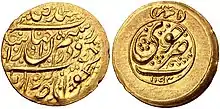
In the wake of the demise of the Safavids, the Ottomans took Khoy on 6 May 1724, a territorial gain which was confirmed with Imperial Russia through the Treaty of Constantinople (1724).[18]
Until 1828, Khoy had a large number of Armenians; however, the Treaty of Turkmenchay (1828), gave the Russians the right to encourage Armenians to immigrate into the Russian Empire. Nevertheless, a small Armenian population remained living in Khoy. This was noted by an American missionary in 1834.[19] He noted further that in the villages around Khoy there were a few more, but the vast majority had migrated to the North of the Aras river following Russia's victory over Persia in 1828 and the encouraged settling in the newly incorporated Russian regions of Eastern Armenia.[19]
With the advent of the 1910s, Khoy was occupied by Ottoman troops, but they were completely expelled from the area by the Russians by 1911.[20] Khoy was one of the many cities in Iran which garrisoned Russian infantry and Cossacks.[20] The Russians retreated at the time of Enver Pasha's offensive in the Iran-Caucasus region, but returned in around early 1916, and stayed in the region up to the wake of the Russian Revolution.[20] In 1918, for a final brief period, the Ottomans took Khoy until the decisive end of World War I and the Armistice of Mudros.[20] In World War II, Khoy was again occupied by Soviet troops, who remained until 1946. After 1946 the city indefinitely became part of Iran and is located in the far northwest of the country.
Climate
Köppen-Geiger climate classification system classifies its climate as cold semi-arid (BSk).[21]>
| Climate data for Khoy | |||||||||||||
|---|---|---|---|---|---|---|---|---|---|---|---|---|---|
| Month | Jan | Feb | Mar | Apr | May | Jun | Jul | Aug | Sep | Oct | Nov | Dec | Year |
| Average high °C (°F) | 2.8 (37.0) |
5.2 (41.4) |
11.6 (52.9) |
17.2 (63.0) |
23.9 (75.0) |
29.3 (84.7) |
32.6 (90.7) |
32.7 (90.9) |
28.0 (82.4) |
20.5 (68.9) |
13.1 (55.6) |
6.4 (43.5) |
18.6 (65.5) |
| Daily mean °C (°F) | −1.4 (29.5) |
0.6 (33.1) |
6.1 (43.0) |
11.2 (52.2) |
16.9 (62.4) |
21.4 (70.5) |
24.7 (76.5) |
24.5 (76.1) |
19.6 (67.3) |
13.6 (56.5) |
7.5 (45.5) |
1.9 (35.4) |
12.2 (54.0) |
| Average low °C (°F) | −5.6 (21.9) |
−4.0 (24.8) |
0.6 (33.1) |
5.3 (41.5) |
9.9 (49.8) |
13.5 (56.3) |
16.9 (62.4) |
16.3 (61.3) |
11.3 (52.3) |
6.7 (44.1) |
2.0 (35.6) |
−2.6 (27.3) |
5.9 (42.5) |
| Average precipitation mm (inches) | 28 (1.1) |
20 (0.8) |
31 (1.2) |
47 (1.9) |
54 (2.1) |
21 (0.8) |
7 (0.3) |
5 (0.2) |
8 (0.3) |
22 (0.9) |
22 (0.9) |
19 (0.7) |
284 (11.2) |
| Source: Climate-Data.org, altitude: 1136m[21] | |||||||||||||
Sights
Khoy is well known for the tomb of Shams Tabrizi, renowned Iranian poet and mystic.
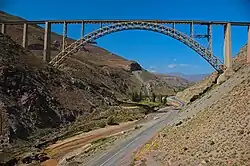
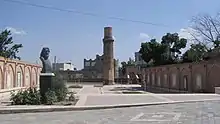

 city center square
city center square Khoy bazaar
Khoy bazaar historical Kabiri House in Khoy
historical Kabiri House in Khoy Khoy Airport
Khoy Airport Stone gate of Khoy
Stone gate of Khoy Kabiri House
Kabiri House Kabiri House
Kabiri House Kabiri House
Kabiri House

 Mahlezan church
Mahlezan church
 Tomb of Shams Tabrizi
Tomb of Shams Tabrizi Tomb of Shams Tabrizi
Tomb of Shams Tabrizi Stone gate of Khoy
Stone gate of Khoy
Famous places
- Tomb of Shams Tabrizi, Shams Tabrizi Tower
- Bastam and Bolourabad Castles
- Khatoon Bridge
- Old Stone Gate
- Old Bazaar
- Motallebkhan Mosque
- Mount Avrin
- Ghotour Iron Bridge[22]
- Surp Sarkis Church
- Pourya-ye Vali
Notable natives
For a complete list see: Category:People from Khoy
.jpg.webp) Mullah Nasreddin, satirical Sufi.
Mullah Nasreddin, satirical Sufi.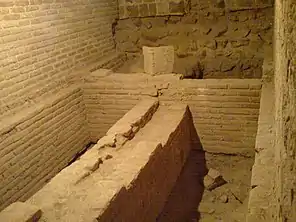 Jahan Shah, was the leader of the Kara Koyunlu oghuz Turks tribal federation in Azerbaijan and Arran.
Jahan Shah, was the leader of the Kara Koyunlu oghuz Turks tribal federation in Azerbaijan and Arran.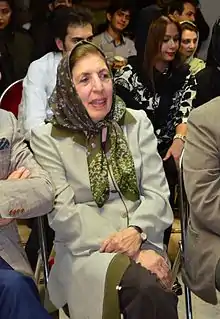 Jaleh Amouzgar , is an Iranologist and a university professor.
Jaleh Amouzgar , is an Iranologist and a university professor. Behrouz Vossoughi, is an Iranian actor.
Behrouz Vossoughi, is an Iranian actor.
See also
- Donboli (tribe)
- Khoy Khanate
- Nor Shirakan
- Zaravand
References
- OpenStreetMap contributors (6 March 2023). "City, Khoy County" (Map). OpenStreetMap. Retrieved 6 March 2023.
- "Xoy, Iran Page". Retrieved 7 July 2008.
- "Census of the Islamic Republic of Iran, 1395 (2016)". AMAR (in Persian). The Statistical Center of Iran. p. 04. Archived from the original (Excel) on 30 August 2022. Retrieved 19 December 2022.
- "چوار کۆڵبەر لە سنورەکانی بانە و خۆی کوژران و برینداربون" (in Kurdish). 9 May 2020. Retrieved 1 August 2020.
- Khoy can be found at GEOnet Names Server, at this link, by opening the Advanced Search box, entering "-3071618" in the "Unique Feature Id" form, and clicking on "Search Database".
- "Census of the Islamic Republic of Iran, 1385 (2006)". AMAR (in Persian). The Statistical Center of Iran. p. 04. Archived from the original (Excel) on 20 September 2011. Retrieved 25 September 2022.
- "Census of the Islamic Republic of Iran, 1390 (2011)" (Excel). Iran Data Portal (in Persian). The Statistical Center of Iran. p. 04. Retrieved 19 December 2022.
- encyclopaedia islamica:اهالی شهرستان خوی به زبان ترکی سخن میگویند (صدراییخویی، 1373ش، ص 65)
- Encyclopedia of Islamic World:به جز ساکنان حاشیه غربی شهرستان خوی که بیشتر کرد هستند؛ اکثریت جمعیت منطقه (بیش از ۹۰٪) شیعه دوازده امامیاند. کردهای این منطقه بیشتر به صورت عشایری زندگی میکنند و از دو طایفه مستقل کرهسنی و مدرومی هستند
- Andrew Burke, "Iran" pp. 138. Lonely Planet. ISBN 1742203493
- Lida Balilan Asl, Elham Jafari. "Khoy's Expansion from Early Islam to Late Qajar According to Historical Documents" published spring 2013. vol 3
- Manandian 1965, p. 113.
- Minorsky, Vladimir (1953). Studies in Caucasian History: I. New Light on the Shaddadids of Ganja II. The Shaddadids of Ani III. Prehistory of Saladin. CUP Archive. p. 52. ISBN 978-0-521-05735-6.
- L. Baker, Patricia; Smith, Hilary; Oleynik, Maria (2014). Iran. London, United Kingdom: Bradt Travel Guides. p. 158. ISBN 978-1841624020.
- Salia, Kalistrat (1983). History of the Georgian nation. Madison, WI: University of Wisconsin. p. 181.
- Mikaberidze, Alexander (2011). Conflict and Conquest in the Islamic World: A Historical Encyclopedia, Volume 1. Santa Barbara, California, USA: ABC-CLIO. p. 196. ISBN 978-1598843361.
- Tamta's World by Anthony Eastmond, page 108
- Somel, Selcuk Aksin (2003). Historical Dictionary of the Ottoman Empire. Scarecrow Press. p. xlvi. ISBN 978-0810866065.
- Smith noted that the city had between 4000 and 7000 Muslim families, while only about 100 Armenian families were left. Smith, Eli (1834). Missionary Researches in Armenia: Including a Journey through Asia Minor, and into Georgia and Persia. G. Wightmann. p. 315.
- Atabaki 2006, p. 70.
- "Climate: Khoy - Climate graph, Temperature graph, Climate table". Climate-Data.org. Retrieved 9 September 2013.
- "Ghotour Valley Bridge". American Bridge Company. Archived from the original on 23 February 2013. Retrieved 25 March 2013.
- "Rumi Remembered in Birthplace of Shams". Archived from the original on 7 April 2015. Retrieved 21 March 2015.
Sources
- Atabaki, Touraj (2006). Iran and the First World War: Battleground of the Great Powers. I.B.Tauris. ISBN 978-1860649646.
- Gledhill, Kevin (2022). "Khoy (Ḵoy)". In Yarshater, Ehsan (ed.). Encyclopædia Iranica, Online Edition. Encyclopædia Iranica Foundation.
- Manandian, Hakop (1965). Garsoïan, Nina (ed.). The Trade and Cities of Armenia in Relation to Ancient World Trade. Livraria Bertrand. (registration required)
